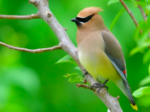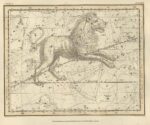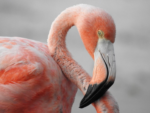Every Friday we invite you and your homeschool students to learn about a different group of North American birds in your recommended bird guide. It’s a great way to add a few minutes of science, geography, natural history, and imagination to your homeschool schedule throughout the year.
The end of the homeschool year is approaching and this week we’ve reached the end of our grand ornithological tour! We’re going to wrap things up for the year by looking at the appendix in your bird guide, which covers Accidental and Extinct Species of North American birds (pages 546–563).
Accidentals are species that are not normally found in a given area but on rare occasions may turn up there by accident. Extinct species are, well, extinct — dead and gone. Here’s the heading for these birds in your bird guide:
ACCIDENTALS · EXTINCT SPECIES. These 94 species have been recorded for N.A. [North America], but for most there are fewer than three records in the past two decades or five records in the last hundred years. Four species that have gone extinct in the past two centuries are also included.
“Accidentals” are of course only accidental with respect to a given location. Species that are accidental in North America (or more locally, in your state or region) may be perfectly common somewhere else. Consider the handsome Swallow-tailed Gull, for example (bird guide page 551). This widespread species is native to the southeastern Pacific Ocean and the west coast of South America. But twice — in 1985 and in 1996 — an individual Swallow-tailed Gull turned up on the coast of California, very far from the species’ normal range.
Accidentals are much sought after by birders who like to keep “life lists” of the birds they’ve seen in a particular area. It’s always a thrill to see a rara avis in terris — a rare bird in the land — and to wonder how it got there. Scientifically, accidentals can be leading indicators of a long-term range expansions. Cattle Egrets (page 260 in the main section of your bird guide) now occur regularly across much of the southern and central United States, but prior to the 1950s they were completely unknown outside of a few accidental records in Florida. Originally an African species, it’s thought that a few individuals somehow made their way across the Atlantic in the middle of the last century (or perhaps hitched a ride on a cargo ship). They hopped off in South America and have been expanding their range in our hemisphere ever since. Not all accidentals are signs of birds to come, however. Some are just accidental and remain so indefinitely.

Several species of birds have become extinct in North America since scientific observations began. Most people will recognize some of them by name: the Passenger Pigeon (page 547), the Great Auk (page 551), and the Carolina Parakeet (page 557). Less well known perhaps are the Labrador Duck (page 546), the Eskimo Curlew (page 550), and Bachman’s Warbler (page 563), the last of which is probably extinct, although some people hold out hope that a few individuals may still survive in the swamps of South Carolina.
You can do little ten-minute lessons of this kind with any of the species in your bird guide that catch your interest — and these accidental and extinct species in particular all have interesting stories behind them. Pick one that has occurred near you, or that looks striking, or that has a strange name, and explore.

In all these Friday Bird Families lessons, our aim is not to present a specific set of facts to memorize. We hope instead to provide examples and starting points that you and your students can branch away from in many different directions. We also hope to show how you can help your students develop the kind of careful skills in reading, observation, and interpretation that they will need in all their future academic work.
What ornithological observations and naturalistical notes have you and your students made in your homeschool this Hercules Term? 😊
❡ Homeschool birds: We think bird study is one of the best subjects you can take up in a homeschool environment. It’s suitable for all ages, it can be solitary or social, it can be as elementary or as advanced as you wish, and birds can be found just about anywhere at any season of the year. Why not track your own homeschool bird observations using the free eBird website sponsored by Cornell University. It’s a great way to learn more about what’s in your local area and about how bird populations change from season to season. 🦅
❡ Feed the birds: Setting up a bird feeder is one of the easiest educational activities you can do in a homeschool environment. Here are some tips that will help you get started today! 🐦
❡ Enchiridion: The front matter in your bird guide (pages 6–13) explains a little bit about basic bird biology and about some of the technical terminology used throughout the book — why not have your students study it as a special project. Have them note particularly the diagrams showing the parts of a bird (pages 10–11) so they’ll be able to tell primaries from secondaries and flanks from lores. 🦉
❡ Words for birds: You may not think of your homeschool dictionary as a nature reference, but a comprehensive dictionary will define and explain many of the standard scientific terms you will encounter in biology and natural history, although it will not generally contain the proper names of species or other taxonomic groups that aren’t part of ordinary English. (In other words, you'll find “flamingo” but not Phoenicopterus, the flamingo genus.) One of the most important things students should be taught to look for in the dictionary is the information on word origins: knowing the roots of scientific terms makes it much easier to understand them and remember their meaning. 📖
❡ Come, here's the map: Natural history and geography are deeply interconnected. One of the first questions you should teach your students to ask about any kind of animal or plant is, “What is its range? Where (in the world) does it occur?” Our recommended homeschool reference library includes an excellent world atlas that will help your students appreciate many aspects of biogeography, the science of the geographical distribution of living things. 🌎
❡ Nature notes: This is one of our regular Friday Bird Families posts for homeschool naturalists. Print your own copy of our River Houses Calendar of American Birds and follow along with us! You can also add your name to our free weekly mailing list to get great homeschool teaching ideas delivered right to your mailbox all through the year. 🐦 🦉 🦆 🦃 🦅
❡ Homeschool calendars: We have a whole collection of free, printable, educational homeschool calendars and planners available on our main River Houses calendar page. They will help you create a light and easy structure for your homeschool year. Give them a try today! 🗓
❡ Support our work: If you enjoy our educational materials, please support us by starting your regular Amazon shopping from our very own homeschool teaching supplies page. When you click through from our page, any purchase you make earns us a small commission at no extra cost to you. Thank you for helping us to keep going and growing! 🛒
❡ Join us! The aim of the River Houses project is to create a network of friendly local homeschool support groups — local chapters that we call “Houses.” Our first at-large chapter, Headwaters House, is now forming and is open to homeschoolers everywhere. Find out how to become one of our founding members on the Headwaters House membership page. 🏡




